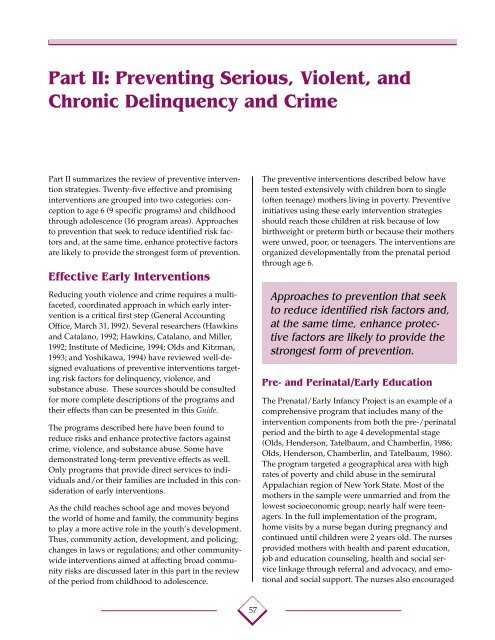uide for Implementing the Comprehensive Strategy for Serious ...
uide for Implementing the Comprehensive Strategy for Serious ...
uide for Implementing the Comprehensive Strategy for Serious ...
Create successful ePaper yourself
Turn your PDF publications into a flip-book with our unique Google optimized e-Paper software.
Part II: Preventing <strong>Serious</strong>, Violent, and<br />
Chronic Delinquency and Crime<br />
Part II summarizes <strong>the</strong> review of preventive intervention<br />
strategies. Twenty-five effective and promising<br />
interventions are grouped into two categories: conception<br />
to age 6 (9 specific programs) and childhood<br />
through adolescence (16 program areas). Approaches<br />
to prevention that seek to reduce identified risk factors<br />
and, at <strong>the</strong> same time, enhance protective factors<br />
are likely to provide <strong>the</strong> strongest <strong>for</strong>m of prevention.<br />
Effective Early Interventions<br />
Reducing youth violence and crime requires a multifaceted,<br />
coordinated approach in which early intervention<br />
is a critical first step (General Accounting<br />
Office, March 31, l992). Several researchers (Hawkins<br />
and Catalano, 1992; Hawkins, Catalano, and Miller,<br />
1992; Institute of Medicine, 1994; Olds and Kitzman,<br />
1993; and Yoshikawa, 1994) have reviewed well-designed<br />
evaluations of preventive interventions targeting<br />
risk factors <strong>for</strong> delinquency, violence, and<br />
substance abuse. These sources should be consulted<br />
<strong>for</strong> more complete descriptions of <strong>the</strong> programs and<br />
<strong>the</strong>ir effects than can be presented in this G<strong>uide</strong>.<br />
The programs described here have been found to<br />
reduce risks and enhance protective factors against<br />
crime, violence, and substance abuse. Some have<br />
demonstrated long-term preventive effects as well.<br />
Only programs that provide direct services to individuals<br />
and/or <strong>the</strong>ir families are included in this consideration<br />
of early interventions.<br />
As <strong>the</strong> child reaches school age and moves beyond<br />
<strong>the</strong> world of home and family, <strong>the</strong> community begins<br />
to play a more active role in <strong>the</strong> youth’s development.<br />
Thus, community action, development, and policing;<br />
changes in laws or regulations; and o<strong>the</strong>r communitywide<br />
interventions aimed at affecting broad community<br />
risks are discussed later in this part in <strong>the</strong> review<br />
of <strong>the</strong> period from childhood to adolescence.<br />
57<br />
The preventive interventions described below have<br />
been tested extensively with children born to single<br />
(often teenage) mo<strong>the</strong>rs living in poverty. Preventive<br />
initiatives using <strong>the</strong>se early intervention strategies<br />
should reach those children at risk because of low<br />
birthweight or preterm birth or because <strong>the</strong>ir mo<strong>the</strong>rs<br />
were unwed, poor, or teenagers. The interventions are<br />
organized developmentally from <strong>the</strong> prenatal period<br />
through age 6.<br />
Approaches to prevention that seek<br />
to reduce identified risk factors and,<br />
at <strong>the</strong> same time, enhance protective<br />
factors are likely to provide <strong>the</strong><br />
strongest <strong>for</strong>m of prevention.<br />
Pre- and Perinatal/Early Education<br />
The Prenatal/Early Infancy Project is an example of a<br />
comprehensive program that includes many of <strong>the</strong><br />
intervention components from both <strong>the</strong> pre-/perinatal<br />
period and <strong>the</strong> birth to age 4 developmental stage<br />
(Olds, Henderson, Tatelbaum, and Chamberlin, 1986;<br />
Olds, Henderson, Chamberlin, and Tatelbaum, 1986).<br />
The program targeted a geographical area with high<br />
rates of poverty and child abuse in <strong>the</strong> semirural<br />
Appalachian region of New York State. Most of <strong>the</strong><br />
mo<strong>the</strong>rs in <strong>the</strong> sample were unmarried and from <strong>the</strong><br />
lowest socioeconomic group; nearly half were teenagers.<br />
In <strong>the</strong> full implementation of <strong>the</strong> program,<br />
home visits by a nurse began during pregnancy and<br />
continued until children were 2 years old. The nurses<br />
provided mo<strong>the</strong>rs with health and parent education,<br />
job and education counseling, health and social service<br />
linkage through referral and advocacy, and emotional<br />
and social support. The nurses also encouraged

















